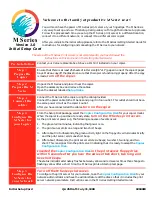
9-26 Upgrading Your Server
Notes on configuring RAID System
Observe the following notes on configuring a RAID System:
The installed hard disk drives (SAS drives or SATA drives) must have the same capacity
and the same rotational speed. The minimum number of required disks depends on the
configuration of RAID.
Select/set a RAID level "RAID0", "RAID1", or "RAID5" for 2.5-inch disk model,
"RAID0" or "RAID1" for 3.5-inch model.
When installing a system in an internal hard disk drive, you should use "Express Setup" to perform
all the procedures for RAID System configuration, OS installation, and then OS setup.
Use Express Setup even when not installing a system. Start Express Setup, select [OS selection]
→
[Others]. The installer automatically performs all the procedures for RAID System configuration,
and then maintenance utility installation.
When making the setup in manual mode, use the RAID System configuration utility in the chip on
the board. You can start the utility during execution of POST that automatically starts immediately
after you turn on the server. For details on the data transfer rate, RAID, and RAID System
configuration, see Chapter 4 and the manual provided with the RAID Controller (N8103-116/117).
IMPORTANT:
When N8103-116/117 is installed, do not let the
system enter hibernation or standby mode.
Summary of Contents for N8100-1573F
Page 16: ...x This page is intentionally left blank...
Page 19: ...Notes on Using Your Server 1 3 3 5 inch Disk Model FRONT REAR...
Page 126: ...4 50 Configuring Your Server This page is intentionally left blank...
Page 296: ...A 2 Specifications This page is intentionally left blank...
Page 304: ...C 2 IRQ This page is intentionally left blank...
Page 333: ...Installing Windows Server 2008 D 29 4 Activate Windows The Windows activation is complete...
Page 390: ...G 2 Using a Client Computer Which Has a CD Drive This page is intentionally left blank...
Page 394: ...H 4 Product Configuration Record Table This page is intentionally left blank...
















































